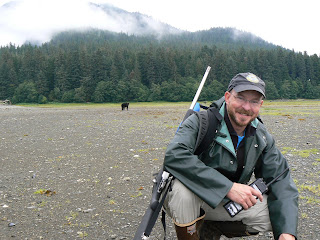 The above photo is the USFWS vessel Curlew on a rare sunny moring in September.
The above photo is the USFWS vessel Curlew on a rare sunny moring in September.While it's always important for me to keep my friends and family upated about my adventures I am appreciative of all the people who visit this site. This is not an official posting for any agency. These are merely my own thoughts and experiences while working and living in AK.
We went back to Kuiu Island again this year for about six weeks to continue our study of the marten population. This time was a bit different though. We did the first two weeks in the Tebenkof Wilderness working aboard the vessel Curlew. Using skiffs to get to shore was the only way to work efficiently in this roadless wilderness. To the best of my knowledge only a small portion of it was logged back in the 1940s and most of the places we worked were old growth forest. This was a strong contrast to the northern portion of the island which has been heavily logged.
We took the Curlew from Petersburg, AK around the north end of Kuiu Island taking a full day to make it to Tebenkof Bay. It was a bit of a rough day but not too rough for the 65 foot vessel and we saw numerous marine mammals including breaching humpback whales followed twenty minutes later by Orcas breaching. It was a good distraction from the knowledge that we had many rainy days of work ahead. Tebenkof is an incredibly beautiful place that's know in part for it's high sea otter population. I've always seen lots of them around Kuiu Island but there seemed to be more in Tebenkof where there were "rafts" of 40-50 at a time floating in the kelp. They are very charismatic creatures that are fun to watch as they float by in the Kelp grooming themselves. Unlike other marine mammals that depend on blubber to maintain body heat sea otters only have ~2% body fat. How do they keep warm when the water temperature is in the 40s? They have very dense fur which traps air to keep them warm. If their fur becomes matted with dirt or oil and can't trap air the they'll die of hypothermia. That's why they seemed to be constantly grooming themselves when they're not eating or playing. They're beautiful animals and entertaining to watch but they can be the bane of a commercial fishermans existence. Here in southeast AK there's lots of grumbling about all the shell fish they eat and there's currently at least one study to estimate the current population.
I grew up a mile from the Atlantic Ocean with white sandy beaches but Alaska is different. The tides can change by as much as 25 feet in a single day. Instead of sandy beaches most of the shoreline is very rocky in the area we were working. Every day the tide was different so we had to be extremely careful not to hit the hull (or worse the prop) on the rocks as we came in to shore. On many days water was too rough to keep the boat on shore so I'd have to jump off the bow of the boat and push it immediately back off shore while the operator backed away as quickly as possible. The fear was that the wind would blow the boat onto a rock with an out going tide and then the boat would get stuck and we'd spend the next six hours waiting for the tide to come back in hoping the waves wouldn't beat up the boat too much. Anyone who boats in southeast AK has to worry about this when the weather isn't cooperating. There's a lot to keep track of while boating in southeast Alaska. I've seen more than one boat (an even one float plane) go dry when someone didn't pay attention to the outgoing tide.
Sea otters weren't the only marine mammals in Tebenkof. There were also lots of harbor seals and we even had a couple of Orcas swimming around our skiffs on one of the rare sunny mornings. We had a truly surreal moment one day when I walked back to the boat which was near the mouth of a salmon stream. A bunch of harbor seals had gathered there to forage on the salmon and became curious about us. My boss was telling me he counted 34 seals swimming toward the boat which was beached and I was taking photos of them when suddenly we heard wolves howling less than 1000m away. It sounded like a pack of several wolves with pups yelping in the mix. We never saw them that day but I'll never get tired of that sound. It's quite an eerie feeling that I can't really describe well in words.
A few days later we saw a black bear sow with three spring cubs walking the coast in a nearby bay. It wasn't all fun. There were a lot of cold, windy, rainy days which meant putting some damp clothes back on day after day(typical when you work in the worlds largest temperate rainforest).
After about two weeks of work on the Curlew we dropped a few people off at Rowan Bay to begin the next month of work. Two of us took the boat ride back to Juneau so that we could help the captain tie off at the dock, etc. It turned out to be a gorgeous sunny day with a beautiful sunset and a full moon over the mountains. An amazing end to a great couple of weeks.
More photos in the next post!

1 comment:
Carl, Great to catch up with your adventures! What an amazing life you lead.
Post a Comment